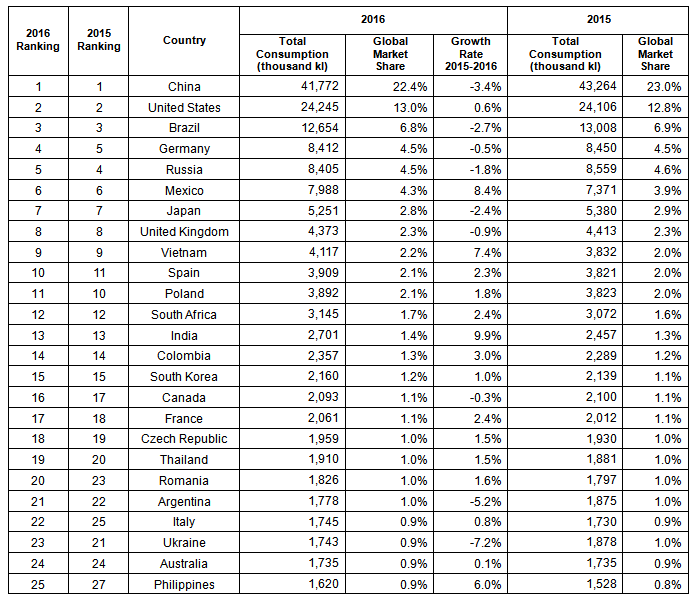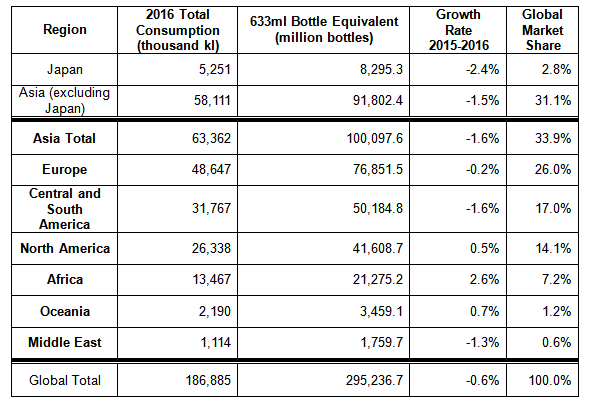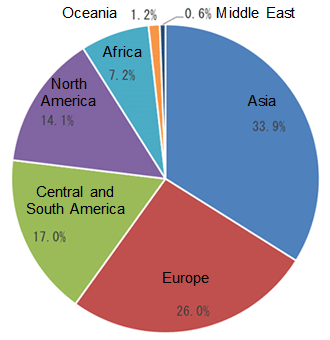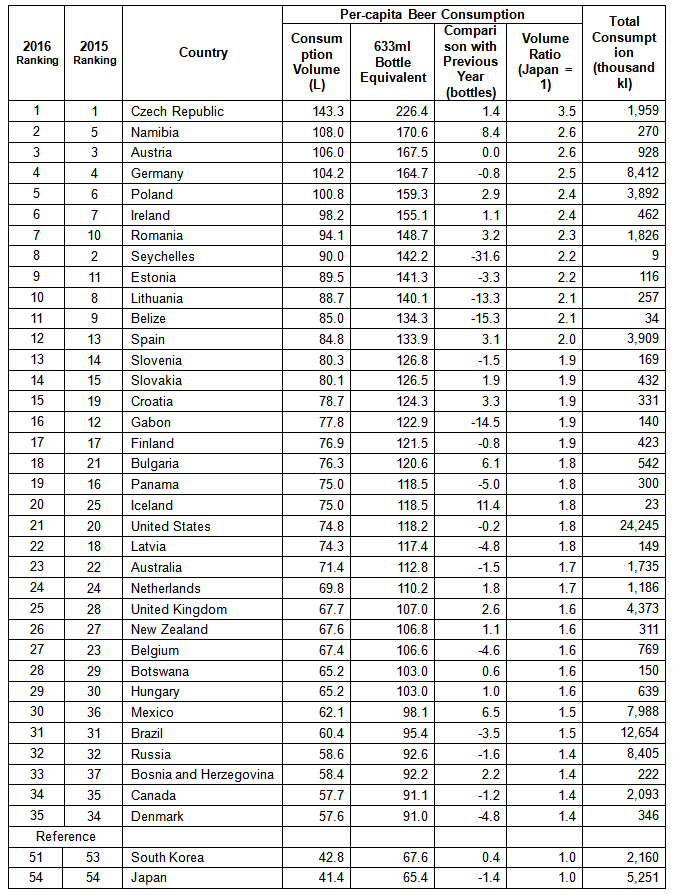- Home
- Newsroom
- News Releases
- 2017
- Kirin Beer University Report Global Beer Consumption by Country in 2016

Kirin Beer University Report Global Beer Consumption by Country in 2016
Global beer consumption falls year-on-year for the second year in a row; Asia remains the top beer-consuming region for the ninth consecutive year
Kirin Company, Limited (President and CEO: Yoshinori Isozaki; hereafter “Kirin”) operates the Kirin Beer University (http://www.kirin.co.jp/entertainment/daigaku/), a virtual university on the Internet which was established in July 2001 to promote the enjoyment of beer and deep knowledge about beer to consumers. With various faculties and facilities, consumers can learn about a variety of topics, ranging from the best way to drink delicious beer to other interesting facts about beer—24 hours a day, 365 days a year.
This report for 2016 publishes the details of global beer consumption in 170 major countries and regions. The report is based on findings obtained from questionnaires sent by Kirin to various brewers’ associations around the world, as well as the latest industry statistics available overseas. The data for global beer consumption has been tracked by Kirin since 1975.
Main Topics
- Global beer consumption stood at approximately 186.89 million kiloliters in 2016, down 0.6% from the previous year, marking the second year-on-year decline in a row. If the volume of the Tokyo Dome was compared to a beer mug, this level of consumption is equivalent to filling up the Tokyo Dome about 151 times over.
- China remained the largest beer-consuming country in the world for the 14th consecutive year; however, consumption decreased significantly in 2016 by 3.4% year-on-year, causing total global consumption to fall. Mexico, in sixth place, marked an 8.4% increase in beer consumption, maintaining growth for two years in a row. The United States, in second place, saw an increase in beer consumption for the first time in two years.
- By region, Asia consumed 1.6% less beer in 2016 compared to 2015, but still holds a 33.9% share of the global beer market, remaining the world’s largest beer-consuming region for the ninth consecutive year. Beer consumption in Africa went up 2.6% from the previous year, marking its sixth year of growth.
In 2016, the global beer consumption was 186.89 million kiloliters (equivalent to approximately 295.2 billion 633ml bottles), with a decrease of about 1,160,000 kiloliters, which is equivalent to 1.8 billion 633ml bottles. In comparison with 2015, there was an annual decrease of 0.6%. The total volume of the global beer consumption is equivalent to about 151 Tokyo Domes, if the stadium was a beer mug with a capacity of about 1.24 million kiloliters.
1. Global Beer Consumption by Country in 2016 (Table 1)
- China remained the largest beer-consuming country in the world for the 14th consecutive year since 2003, despite a decrease of 3.4% compared to 2015.
- Among the world’s top 25 beer-consuming countries, India achieved the highest growth of 9.9%.
- Japan was ranked seventh for the 10th consecutive year, consuming 2.4% less beer than 2015.
2. Global Beer Consumption by Region in 2016 (Table 2)
- Although beer consumption decreased in the Asia, Europe, Central and South America, and Middle East regions, other regions saw consumption increase.
- Asia remained the world’s largest beer-consuming region for the ninth consecutive year, despite a decrease of 1.6% compared to the previous year. Although annual consumption increased in India (+9.9%), Vietnam (+7.4%), and South Korea (+1.0%), the decrease in China (-3.4%) resulted in the overall decline.
- Beer consumption in Africa grew for the sixth consecutive year, with an annual increase of 2.6% in 2016.
3. Per-capita Beer Consumption by Country in 2016 (Table 3)
- Czech Republic remained the world’s top in per-capita beer consumption for the 24th consecutive year.
- Among the top 35 countries, 17 saw an increase in consumption from 2015 to 2016.
- Japan consumed 41.4 liters of beer—the equivalent of 65.4 bottles (633ml)—on a per-capita basis in 2016, down 1.4 bottles year-on-year.
The Kirin Group will aim to create a new beverage culture together with consumers, as well as to further energize and enrich people and society.
Note: Consumption volume in Japan is a combination of beer, happo-shu (low-malt beer), and new genre (non-malt beer). Due to rounding, the figures may not necessarily add up.
Among the countries whose figures for the previous year were revised for this year’s report, the revised figures are used to calculate year-on-year changes.
- *The volume of global consumption for the previous year has been updated (revised from 183.78 million kiloliters to 188.05 million kiloliters).
Source: Questionnaires sent by Kirin to the brewers’ associations in major countries.
The Barth Report Hops 2016/2017 (BARTH−HAAS GROUP)
Global Beverage Forecasts September 2017 (Canadean Ltd.)
- *As of 2013, there has been a change in the industry statistics data source. Therefore, some of the data may not necessarily correspond with past reports.
Table 1: Global Beer Consumption by Country in 2016

Comments
- Global beer consumption in 2016 was approximately 186.89 million kiloliters, down 0.6% from the previous year, marking the second year-on-year decline in a row.
- China remained the largest beer-consuming country in the world for the 14th consecutive year since 2003. There was a 3.4% decrease in annual beer consumption, marking the third year-on-year decline in a row. The decrease was caused by a maturing market, poor weather over the summer across almost the entire country, and declining sales of beer in mid- to high-range restaurants. On the other hand, the proportion of people drinking beer increased, due both to heightened interest in alcohol among young adults and to the widespread availability of alcohol over the Internet.
- In the United States, where annual beer consumption increased by 0.6% year-on-year, there was a significant increase in sales of imported beer. Continuing the trend from 2015, there was an increase in consumption of premium beer and craft beer led by young adults seeking unique flavors and originality. In particular, craft beer consumption in the United States has been strong, with the market share of craft beer rising to 12%.
- The United Kingdom saw a slight decline of 0.9% in annual beer consumption due to both political and social pressures on its market environment.
- In Russia, annual beer consumption fell for the second year in a row. Consumption was down by 1.8% over the previous year due to bans on advertising and increased taxes.
- Japan’s ranking remained unchanged for the 10th year in succession. However, annual beer consumption decreased by 2.4% compared to 2015 due mainly to poor weather during the summer months, when beer consumption is at its peak.
- In the Philippines, increased consumption following the general elections of May 2016, economic growth, and a falling unemployment rate all contributed to a significant year-on-year rise in beer consumption of 6.0%.
- In Myanmar, annual beer consumption rose by 8.3% compared to 2015. Sales of alcoholic beverages in the country continue to grow, due both to the entry of overseas beer manufacturers into local markets and to the increased spending power of its citizens.
Table 2: Global Beer Consumption by Region in 2016

Note: Consumption volume in Japan is a combination of beer, happo-shu (low-malt beer), and new genre (non-malt beer).
2016 Global Market Share of Beer Consumption by Region

Comments
- Annual beer consumption in Asia was the highest in the world for the ninth consecutive year, although there was a decrease of 1.6% from the previous year, with its global market share dropping to 33.9% from last year’s 34.2%.
- Asia remained the top beer-consuming region led by the increase in annual beer consumption in India, Vietnam, and South Korea of 9.9%, 7.4%, and 1.0% respectively. However, consumption in China fell by 3.4% year-on-year, leading to an overall decrease in regional consumption for the third year in a row.
- Central and South America, ranking third, recorded a decrease of 1.6% from the previous year. Despite increased consumption in Mexico and Colombia of 8.4% and 3.0% respectively, Brazil’s decrease of 2.7% had an effect on the region’s overall decline.
Table 3: Per-capita Beer Consumption by Country in 2016

Comments
- Czech Republic led all other nations in per-capita beer consumption for the 24th consecutive year.
- Among the top 35 countries ranked by per-capita beer consumption, 17 increased consumption levels from 2015 to 2016.